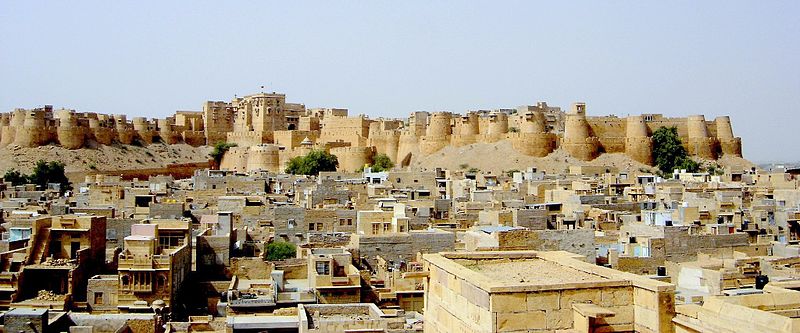Jaisalmer Fort
Fort Rd, Amar Sagar Pol, Jaisalmer, Rajasthan 345001
Phone: +91-2992-252406
Jaisalmer Fort is a World heritage site.
Jaisalmer Fort is one of the largest fully preserved fortified cities in the world. It is situated in the city of Jaisalmer, in the Indian state of Rajasthan. It is a World Heritage Site. It was built in 1156 AD by the Rajput ruler Rawal Jaisal, from whom it derives its name. The fort stands amidst the sandy expanse of the great Thar Desert, on Trikuta Hill. Before the days of the British Raj, the fortress city served as a refuge and way-station for caravans and travelers along the Silk Road. Its ramparts served as the backdrop for many battles in past centuries when the Silk Road still served as one of the main trade routes between East and West.
The fort’s massive yellow sandstone walls are a tawny lion colour during the day, fading to honey-gold as the sun sets, thereby camouflaging the fort in the yellow desert. For this reason, it is also known as the Sonar Quila or Golden Fort. The fort is located along the southern edge of the city that bears its name, and is perhaps one of the more striking monuments in the area, its dominant hilltop location making the sprawling towers of its fortifications visible for many miles around.
Architecture
The fort is 1,500 ft (460 m) long and 750 ft (230 m) wide and is built on a hill that raises above a height of 250 ft (76 m) above the surrounding country side. The basement of the fort has a 15 ft (4.6 m) tall wall forming a double line of defence. The bastions of the fort forms a chain about 30 ft (9.1 m). The fort has four entrances to the townside, one of which used to be guarded by cannon.
Raj Mahal (Royal palace)
Jain Temples
Laxminath temple
4 massive gateways
Merchant Havelis. These are large houses often built by wealthy merchants in Rajasthani towns and cities in North India, with ornate sandstone carvings. Some havelis are many hundreds of years old. In Jaisalmer there are many elaborate havelis carved from yellow sandstone. Some of these have many floors and countless rooms, with decorated windows, archways, doors and balconies. Some havelis are today museums but most in Jaisalmer are still lived in by the families that built them. Among these is the Vyas haveli which was built in the 15th century, which is still occupied by the descendants of the original builders. Another example is the Shree Nath Palace which was once inhabited by the prime minister of Jaisalmer. Some of the doors and ceilings are notable examples of old carved wood from many hundreds of years ago.
The fort has an ingenious drainage system called the ghut nali which allows for the easy drainage of rainwater away from the fort in all four directions of the fort. Over the years, haphazard construction activities and building of new roads has greatly reduced its effectiveness.
Culture
The fort has numerous eateries, including Italian, French and native cuisines. The famous Indian film director Satyajit Ray wrote the Sonar Kella (The Golden Fortress), a detective novel, based on the fort and he later filmed it here. The film became a classic and a large number of tourists from Bengal and around the world visit the fort annually to experience for themselves the world that Ray portrayed in the movie.[2] Six forts of Rajasthan, namely, Amber Fort, Chittorgarh Fort, Gagron Fort, Jaisalmer Fort, Kumbhalgarh and Ranthambore Fort were included in the UNESCO World Heritage Site list during the 37th meeting of the World Heritage Committee in Phnom Penh during June 2013. They were recognized as a serial cultural property and examples of Rajput military hill architecture.
Source : Wikipedia
https://www.youtube.com/watch?v=AemZQpZVedM
Reviews
Visiting hours : 12 AM to 12 PM
Entry fee : Free



Rate this article